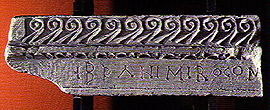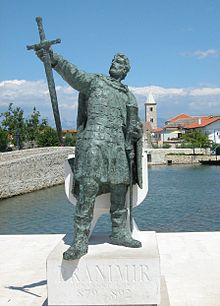- Branimir of Croatia
-
Branimir Duke of Croatia
The monument of knez Branimir in Nin, CroatiaReign 879 – c. 892 Died 892 Predecessor Zdeslav of Croatia Successor Muncimir of Croatia Consort Mariosa Royal House House of Domagojević Branimir (died 892) was a ruler of Dalmatian Croatia who reigned as Knez from 879 to 892. He was recognized by Pope John VIII as the Duke of the Croats (Dux Chroatorum).[1] During his reign, Croatia retained its sovereignty from both Frankish and Byzantine rule, and became a fully recognized state.[2][3]
Contents
Reign
Rise of Branimir's power
 The inscription of duke Branimir, c. 880
The inscription of duke Branimir, c. 880
Branimir was brought to the throne of Croatia by the Anti-Byzantine coalition under the Roman Pope. In 879 Branimir had Zdeslav, a supporter of the Byzantine Empire, killed near Knin in a rebellion that he led. Approval from the Holy See was brought about by Branimir's own actions to bring the Croats further away from the influence of Byzantium and closer to Rome. Duke Branimir wrote to Pope John VIII affirming this split from Byzantine and commitment to the Roman Papacy.
During the solemn divine service in St. Peter's church in Rome in 879, Pope John VIII gave his blessing to the duke and the whole Croatian people, about which he informed Branimir in his letters. Pope John VIII brought the very decision on May 21, 879, and confirmed it in his letter from June 7, 879.[3] This was the first time that the Croatian state was officially recognized (at that time the international legitimacy was given by the Pope).
In Branimir's time Venetians had to pay taxes to the Croatian state for their ships traveling along the Croatian coast. In 880, the Pope ask for help from prince Branimir for an armed escort for his delegates across southern Dalmatia and Zahumlje.[4]
Brainimir's reign and Croatian Church
During Brainimir's reign, the Croatian Bishop of Nin recognized the supreme ecclesiastical authority of the Roman Bishop, unlike the Archbishop of Split, who recognized the supremacy of the Patriarch of Constantinople. Duke Branimir promoted the Croatian Bishop of Nin to the Archbishop of Split, after the Archbishop's death in the Patriarchate of Aquileia without knowledge of the Holy See, which worsened his relations with the Pope. Under the influence of Methodus' baptising missions in 882 who made a stop in Croatia on his way from Moravia to Constantinople, Branimir endorsed parallel usage of Latin and Slavic in the Ecclesiastical service, which was not like by the new Pope, Stephen V. Throughout his life, Duke Branimir worked on increasing Croatian independence.
Branimir died in 892. He was succeeded by Trpimir's third son, Muncimir.
House of Domagojević
Unlike his predecessor and successor (both Trpimirović), some historians impose that Branimir might be a member of the House of Domagojević, particularly, one of his sons. His name is an old Slavic name, and could be translated as "defender of the realm", or "defender of peace", as the word "mir" means peace in Slavic languages.
Legacy and honors
Today, we have several historical monuments (mostly altar beams from old Croatian churches) that bear the name of Duke Branimir. Also, his name is also found in Evangelistar from Cividale together with the name of his (probably) wife Mariosa (Croatian: Maruša or Marija).
Currently, Croatia's government presents the Order of Duke Branimir as one of its highest state honours.
See also
- Branimir Inscription
References
- ^ Fine, John Van Antwerp (1991). The early medieval Balkans: a critical survey from the sixth to the late twelfth century. University of Michigan Press. p. 261. ISBN 0472081497, 9780472081493. http://books.google.com/books?id=YbS9QmwDC58C&pg=RA1-PA108&dq=vlastimir&lr=&as_brr=3&hl=sv#v=onepage&q=Branimir&f=false.
- ^ Hrvatski leksikon (1996-1997) (Croatian)
- ^ a b Stjepan Antoljak, Pregled hrvatske povijesti, Split 1993., str. 43.
- ^ Draganović, Krunoslav (1991). Povijest Bosne i Hercegovine od najstarijih vremena do godine 1463. Hrvatsko kulturno društvo Napredak. p. 191.
Further reading
- Klaić, Vjekoslav (1985) (in Croatian). Povijest Hrvata: Knjiga Prva, Druga, Treća, Četvrta i Peta. Zagreb: Nakladni zavod Matice hrvatske. ISBN 8640100519, 9788640100519.
Regnal titles Preceded by
ZdeslavDuke of Dalmatian Croatia
879–892Succeeded by
MuncimirHouse of Domagojević 

Dukes of Croatia (dux Croatorum, hrvatski knez) dukes of Pannonian Croatia Vojnomir (c. 790 - c. 800–791 - c. 810) • Ljudevit Posavski (810–823) • Ratimir (829–838) • Braslav (880–c. 887)
dukes of Littoral Croatia Radoslav (...–...) • Kuber (...–...) • Porga (c. 640–c. 680) • Budimir (740–785) • Višeslav (785–802) • Borna (810–821) • Vladislav (821–835) • Mislav (835–845) • Trpimir I (845–864) • Zdeslav (864,878–879) • Domagoj (864–876) • Iljko (876–878) • Branimir (879–892) • Muncimir (892–900) • Tomislav I (910–928)Categories:- Dukes of Croatia
- 892 deaths
- Croatian nobility
- Croatian Roman Catholics
- 9th-century births
- Medieval Croatia
- 9th-century rulers in Europe
Wikimedia Foundation. 2010.

